
There are many cultures in the world where alcohol is considered an important social bonding agent. In some places, however, the love affair with alcohol has turned sour, and problem drinking has become a national crisis. To look at alcoholism throughout the world is to look at humanity’s relationship with alcohol through a number of different lenses, each of which tells a unique story.
Drinking around the World
In 2015, the World Health Organization issued a “global status report” on levels of alcohol consumption around the world. Among the findings:
- Every year, there are 3.3 million deaths as a result of dangerous use of alcohol, amounting to 5.9 percent of all global fatalities
- Over 200 disease and injury conditions can be attributed to harmful use of alcohol
- Around 25 percent of the total number of deaths for people aged 20-39 can be traced back to irresponsible alcohol consumption
- Dangerous drinking and a number of mental health and behavioral disorders have a causal relationship with each other; additionally, “noncommunicable conditions” (i.e., injuries) are also taken into consideration
- Other “incidence of infectious diseases” that can be explained by harmful alcohol use are tuberculosis and HIV/AIDS
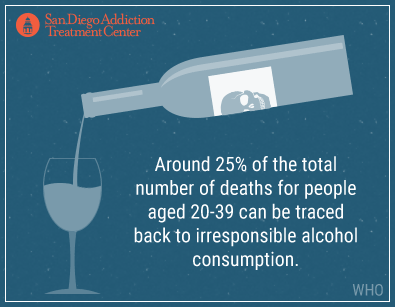
WHO’s 2015 report is an update of a report it issued in 2005, when it found that annual global consumption hit an average of 6.13 liters of pure alcohol (not alcoholic beverages) for every person over the age of 15. While that figure represents the entire world, only 50 percent of the people in the world consume alcohol, and most of them live in developed, wealthier countries. In many places across Asia and Africa, alcohol consumption levels are strikingly low; the production, sale, and consumption of alcoholic beverages range from strictly regulated to totally nonexistent due to religious and ethnic laws.
How Alcohol Conquered Russia
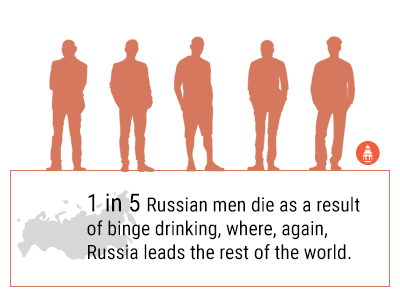
On the other side of the spectrum, the European continent sees more alcohol consumption than any other landmass. In 2005, Europeans drank 12.18 pure liters of alcohol per capita; residents in both North and South America imbibed only 8.67 liters, while Southwest Asia and Africa had much more modest rates of consumption at 6.23 liters and 6.15 liters, respectively. The Daily Beast notes that largely due to Russia’s fondness for vodka, spirits trump beer as Europe’s favorite drink.
After a drunk driver killed seven people at a Moscow bus stop in 2012, the Russian government passed some of the strongest drunk driving laws in the world. Nonetheless, Russia – a country where, CBS News wrote, there is a “chronic culture of drunk driving” – is still home to the most alcohol-related deaths in the world. One in five Russian men die as a result of binge drinking, where, again, Russia leads the rest of the world.
 In explaining “how alcohol conquered Russia,” The Atlantic quotes a historian in the journal of Current History, who wrote in 2000 that 20 million of Russia’s 144 million people are alcoholics. Eleven years later, the World Policy Journal presented the image of “the prototypical Russian”: an alcoholic sitting in a public place, whose only concern is the location and affordability of his next drink.
In explaining “how alcohol conquered Russia,” The Atlantic quotes a historian in the journal of Current History, who wrote in 2000 that 20 million of Russia’s 144 million people are alcoholics. Eleven years later, the World Policy Journal presented the image of “the prototypical Russian”: an alcoholic sitting in a public place, whose only concern is the location and affordability of his next drink.
At various points in its history, the Russian government has tried to do something about how many of its citizens were drinking themselves to death, but a Russian academic writing in the Sociological Research journal laments that after every anti-alcohol campaign, there was “an even greater spread of drunkenness and alcoholism.”
Part of the reason is that even as Russian leaders acknowledged that drinking had gotten out of hand, they also saw the steady flow of alcohol as a benefit to them. When the Soviet Union was in fierce competition with the United States in the middle of the 20th century, party leaders were more concerned with alcohol sales as a source of state revenue than they were the health of their citizens.
The attitude has persisted to the modern day. As recently as 2010, when Russia was reeling from the effects of the Great Recession, former finance minister Aleksei L. Kudrin said that the best thing his countrymen could do to jumpstart the economy was to pay more in taxes by drinking more.
The Heaviest Drinkers in the World

The idea of Russians drinking more, in a country where people drink 18 liters of pure alcohol per person every year (which is over twice the internationally recommended limit), is a dangerous one. The life expectancy for Russian men is only 60 years (compared to 74 years in the United States and 75 years in China) – but makes sense in the context of how integral alcohol is to the Russian story and the Russian psyche. The New York Times references a historian who wrote of an 1859 peasant uprising against the state’s liquor taxes. The peasants signaled their discontent by going sober. In response, police “poured [liquor] into their mouths through funnels,” before arresting them and charging them with rebellion.
Rampant alcoholism in Russia, writes the Times, is nothing new. The country has a long and storied past with alcohol, going as far back as the year 988, when Vladimir the Great converted Russia to Orthodox Christianity, partly due to the denomination not prohibiting drinking. By the 1850s, vodka accounted for nearly half of Russia’s tax revenues.
As much as the Russian government profited financially from the sale of alcohol, it also enjoyed some other benefits. Citizens kept happy by the constant flow of vodka were less likely (and less capable) of expressing any political dissent. The New York Times hypothesized that this was even a method of intentional political suppression.
The party came to an end in 1992, when the Soviet Union collapsed, and the government’s monopoly over alcohol was repealed. With the alcohol industry now becoming privatized, there was a spike in the supply. In 1995, the World Health journal found that drinking levels hit 14.5 liters of pure alcohol per person. As the USSR fell and the Cold War came to an end, Russians were officially the heaviest drinkers in the world.
Drinking Itself to Death
But even as the Russian government changed, Russia’s relationship with alcohol didn’t. The Lancet wrote in 2006 that alcohol taxes are low; a bottle of vodka could cost $1 USD (30 rubles). That accounts for the alcohol that is licensed to be produced; anywhere from 30 percent to 60 percent of the vodka flowing through Russia is made privately and illegally (comparable to moonshine in the United States). Such liquor is untaxed, and therefore, even cheaper than $1 to buy.
The result, says Quartz magazine, is that “Russia is quite literally drinking itself to death.” Quoting data from the World Health Organization, Quartz writes that over 30 percent of all the deaths in Russia in 2012 could be traced back to alcohol, which is the highest rate in the world “by far.” Fatal conditions include:
- Cirrhosis
- Accidents
- Alcohol poisoning
- Suicide
Treating Alcoholism in Russia
There are treatment options for alcohol abuse in Russia, but the Boston Globe warns that they look very different from those in the United States. While the standard form of rehabilitation for a drinking problem in America usually entails months (if not years) of therapy, the Russian version could be nothing more than a single visit to a doctor, a hypnosis session, and a prescription for pills. There is a prohibitively small element of mental health treatment to Russia’s programs.
 The Globe attributes the stark difference to a mix of reasons: religious, cultural, historical, and even medical distrust between the United States and Russia. Millions of Americans have benefitted from a variety of approaches to treat their substance abuse, but generations of mutual suspicion have made for an indifferent (or even hostile) reception on Russian shores. Certain ideas do not translate well across certain borders, no matter how effective they may be at solving a common problem.
The Globe attributes the stark difference to a mix of reasons: religious, cultural, historical, and even medical distrust between the United States and Russia. Millions of Americans have benefitted from a variety of approaches to treat their substance abuse, but generations of mutual suspicion have made for an indifferent (or even hostile) reception on Russian shores. Certain ideas do not translate well across certain borders, no matter how effective they may be at solving a common problem.
But a key reason why Russian treatment programs bear no resemblances to their American counterpart is that Russians and Americans have very contrasting definitions of what constitutes a drinking problem. A Russian medical anthropologist writes that Russians think of a drinking problem as the culmination of chronic alcohol use; the chronic alcohol use itself is thought of as “perfectly normal.” Problem drinking in Russia is only when a person is reduced to lying in a ditch. The idea of functional alcoholism doesn’t exist; someone who can turn up for work, while still drinking poisonous amounts of vodka, would be considered absolutely fine in mainstream Russian society.
Call Now (619) 577-4483
Perfectly Normal Functioning Alcoholics
The reality is that functional alcoholism is an incredibly dangerous form of problem drinking; so-called “high functioning alcoholics” can consume massive amounts of alcohol for a long period of time before anyone realizes that there is something wrong. For a combination of reasons, they are able to maintain families, jobs, and social appearances, while unable to psychologically break their drinking habit. But something inevitably goes wrong, says The New York Times: a DUI, a failed liver, or a threat of divorce. When it does, the situation has deteriorated so far that treatment can be an exceptionally long and difficult process.
The danger of high-functioning alcoholism is generally accepted in the Western hemisphere. In Russia, a disconcertingly large number people would think of the concept as a perfectly normal way of life.
Other cultural differences account for a significant degree of Russian resistance to treatment models born in America. In the past, explains the Boston Globe, force-fed anti-Western suspicion led many Russian doctors and scientists to wonder what the United States government stood to gain from programs as benign as Alcoholics Anonymous. But inherent in Russian culture is the skepticism toward ordinary people possessing the cure. A social scientist says that many people in Russia would scoff at the notion of a person who has experienced the worst of alcoholism being in a position to help others going through the same problem – especially when most Russians would not even consider chronic drinking to be a problem in the first place.
Unorthodox Methods
 The nature of aftercare support treatments like Alcoholics Anonymous is to get members talking to one another about their struggles and successes but even this may be difficult for a Russian person. For most of the 20th century, Russian citizens were intimidated by a dictatorship and police state into keeping their thoughts to themselves. The habit has become second nature; even with Russia becoming a democracy in 1991, modern-day Russians are loath to admit that there is something wrong. A woman who runs a free alcohol recovery center outside the city of Saint Petersburg explained to the Globe that no Russian would consider the act of drinking to be shameful; but drinking as a result of a mental health disorder would be thought of as “very” shameful.
The nature of aftercare support treatments like Alcoholics Anonymous is to get members talking to one another about their struggles and successes but even this may be difficult for a Russian person. For most of the 20th century, Russian citizens were intimidated by a dictatorship and police state into keeping their thoughts to themselves. The habit has become second nature; even with Russia becoming a democracy in 1991, modern-day Russians are loath to admit that there is something wrong. A woman who runs a free alcohol recovery center outside the city of Saint Petersburg explained to the Globe that no Russian would consider the act of drinking to be shameful; but drinking as a result of a mental health disorder would be thought of as “very” shameful.
However, there are signs that the Russian resistance to established treatment methods is changing. In the past, the Russian Orthodox Church was one of the biggest skeptics of the Alcoholics Anonymous method, believing it to be a “religious cult invading the country,” according to Current History. In 2010, however, the Church praised AA as an “effective instrument in rehabilitating drug and alcohol addicts,” but said it would create its own treatment. Raw Story described this as a “wary” change in the mainstream Russian mentality; in a country of 143 million, there are only 10,000 members of 400 AA groups. Most of those 143 million are unlikely to change their ways; Raw Story quoted an Orthodox Christian blogger who rejected AA’s position of “conquering alcoholism [by] themselves.” The blogger went back to the [Orthodox] Church, where alcoholism is conquered “with prayer and fasting.”
Perhaps summing up the opinion of 143 million of his countrymen when it comes to the Russian approach to alcohol treatment, the blogger asked, “Why reinvent the wheel?”
Ireland’s Intoxication
While Russia’s fascination with intoxication is a story in itself, it is the much smaller nation of Ireland that leads the pack. The World Health Organization found that the people of the Emerald isle drank 14.1 liters of pure alcohol per capita.
The Fix writes of the way of life in rural Ireland, where a beer in a pub is as common and everyday an activity as riding a bicycle. Ireland’s Health Research Board found that 72 percent of the country’s residents reported knowing someone who, they feel, drinks too much. The Chief Medical Officer of Ireland, the most senior government advisor on issues of health, reported that ailments related to alcohol consumption – medical problems, crime, public disorder, etc. – cost the country of fewer than 6 billion people approximately 3.7 billion Euros every year ($4.16 billion USD).
Speaking to The Fix, a 25-year-old bartender explained that from a young age, Irish people are expected to get drunk, and “that was all we really did.” The man quit drinking after he fell off a roof.
The issue of young Irishmen and women taking to drink at epidemic levels has sounded alarm bells across the country. The Irish Times lamented in 2012 that while alcohol has always been a part of an Irish person’s coming of age, those people were drinking wine and beer. “Now,” the paper quotes the assistant director of the National Youth Council of Ireland as saying, “it’s spirits, and they’re drinking more and younger.” The result is a new generation of Irish being diagnosed with serious liver problems in their early adulthood.
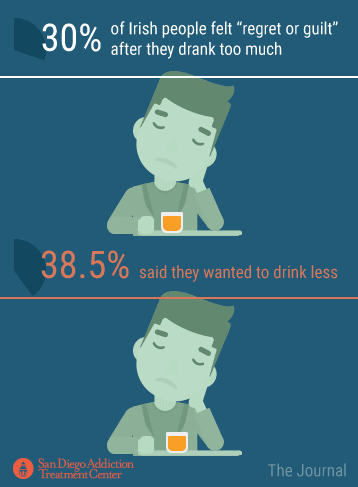
For a generation of Irish people, getting drunk was what they were expected, and pressured, to do. Any form of moderate drinking was greeted with suspicion. If a night out didn’t end with “falling all over the place […] we thought there was something wrong with you,” in the words of a woman who, after becoming sober, struggled to find likeminded friends.
Peer pressure can account for a great degree of risky behavior, especially in a society that prioritizes drinking. A survey reported on in The Journal found that 30 percent of Irish people felt “regret or guilt” after they drank too much, and 38.5 percent said they wanted to drink less.
The Booze Battle
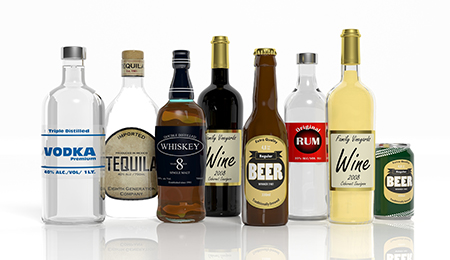 But the Irish propensity for heavy drinking is sowed very deeply into the cultural DNA of the island. The behavior has long been the subject of cultural tales and humor, and only recently has it been looked at as a serious health problem. The dichotomy is what The Irish Times calls “The Booze Battle”; the country recently topped a European survey for at-risk drinking, with 28 percent of Irish people binge drinking, and another 56 percent drinking to harmful levels. In 2007, Ireland’s per capita alcohol consumption was 11.3 liters for every adult; data released by the Organisation for Economic Co-Operation and Development (which includes Canada, the United States, and most of Western Europe) showed that the average among OECD countries was only 9.1 liters.
But the Irish propensity for heavy drinking is sowed very deeply into the cultural DNA of the island. The behavior has long been the subject of cultural tales and humor, and only recently has it been looked at as a serious health problem. The dichotomy is what The Irish Times calls “The Booze Battle”; the country recently topped a European survey for at-risk drinking, with 28 percent of Irish people binge drinking, and another 56 percent drinking to harmful levels. In 2007, Ireland’s per capita alcohol consumption was 11.3 liters for every adult; data released by the Organisation for Economic Co-Operation and Development (which includes Canada, the United States, and most of Western Europe) showed that the average among OECD countries was only 9.1 liters.
Other statistics come from a 2009 report by the Irish Health Board, which found that 54 percent of respondents (or 2.14 million adults out of the country’s population of 4.2 million) drink to the point of harming themselves or those around them; the European average of those who drink to that excess is only 28 percent.
More concern was noted by the World Health Organization, which reported in 2014 that Ireland possesses “the second highest rate of binge drinking in the world.” Adolescents as young as 15 years old were part of the 39 percent of Irish citizens who had engaged in episodes of heavy drinking, which far exceeds Britain’s 28 percent of binge drinkers. The only other country to drink as heavily and dangerously as Ireland was Austria, where 40.5 percent of residents drank too much, too quickly.
Call Now (619) 577-4483
Normalizing Drunkenness
Ireland’s The Journal quotes WHO as saying that 16 percent of alcohol consumers worldwide binge drink, but the rate is three times higher in Ireland. The CEO of Alcohol Action Ireland lays the blame of “the normalization of drunkenness” in Irish society, powered by cheap liquor being sold everywhere, and a marketing juggernaut particularly focusing their targeting efforts on young people.
Over time, this has become the norm. One person speaking to The Fix attributes Ireland’s drinking problem with the fact that, as with Russia, heavy drinking is the norm, and the only time people see it as a problem is when tragedy strikes.
A writer in Ireland’s Independent tells the story of visiting Italy, where he was asked why Irish tourists “hang out in bars all day, ordering round after round.” Baffled and embarrassed, the writer replied, “It’s just our culture,” which the person speaking to The Fix says contributes to the idea that there’s no concept of heavy drinking as a sign of a mental health or behavioral disorder.
Culture is deeply rooted in history. Dr. Garret O’Connor, the founding president of the Betty Ford Institute of Prevention, Research and Education in Addictive Disease, made the point in Irish America that Ireland’s tragic and oftentimes bloody history has given rise to a culture of self-medication. As a country and a people, Ireland has seen generations of religious persecution and land violation, extreme poverty and abuse by a military power, civil war, and terrorism. The island was occupied for 700 years by English colonists, breeding a deep sense of shame and resentment among Irish Catholics, that Dr. O’Connor says has created a culture “where drink has seemed like the only solution.”
A Complex and Deep-Rooted Problem
The point is echoed by the Review of Economics of the Household journal, in which researchers wrote in 2013 that they found “relatively strong influences of […] English colonial settlement” on Irish drinking patterns. The researchers also noted that parental and sibling drinking affected both alcohol consumption itself and perceptions of what is acceptable drinking behavior among Irish families. Put everything together, and Ireland’s problem with drinking is “complex” and “deep-rooted,” says the journal.
Ireland’s maudlin history has long been romanticized, both by the Irish themselves and cultures influenced by the Irish diaspora. An Irish writer in Vice magazine observes that St. Patrick’s Day – which is celebrated in more countries than any other national festival, including in orbit on the International Space Station – is an excuse to wholeheartedly celebrate the stereotype of Irish as drinkers. As much as an occasion like St. Patrick’s Day commemorates Irish heritage and culture, the Vice writer feels that “a sense of guilt remains at the heart of the Irish psyche,” a guilt that is simultaneously buried and honored with alcohol.
Ever since the 18th century, when the discovery of gin led to a wave of heavy drinking, alcohol has remained a deep, inherent part of Irish culture. Even if the Irish wanted to change their ways, says Vice, the process would take decades. Any such desire is purely hypothetical; drinking, and being drunk, is Ireland’s currency. People all over the world identify Irish with alcohol and parties, and, for the most part, the Irish enjoy the designation; partly because of the association with good times, but also because it validates the Irish identity, making Irish people the envy of other cultures where alcohol use is repressed or relegated.
The Destruction of Irish Society
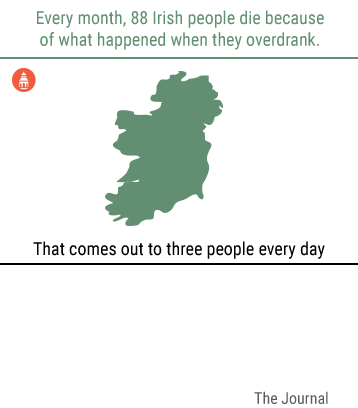
But this reputation is destroying Irish society, notes the Vice writer. Every night, between 1,500 and 2,000 hospital beds are occupied by people who require medical treatment for alcohol-related problems. Ireland’s healthcare budget has to allocate 8.5 percent to spend on alcohol treatment. Of a population of 4.5 million people, 1,200 are diagnosed with cancer every year because of their drinking. More people die in Ireland due to conditions related to alcohol abuse than issues related to every other drug combined; 33 percent of all traffic fatalities, and 25 percent of all male deaths between the ages of 15 and 39 are directly related to alcohol-related causes. Being under the influence of alcohol was cited in nearly 50 percent of cases involving homicide perpetrators, and 76 percent of rape victims were drunk when they were assaulted.
Every month, 88 Irish people die because of what happened when they drank too much. That comes out to three people every day, according to an interpretation of a report from the Health Research Board by The Journal, which also wrote that Irish people drink 11 liters of pure alcohol every year, the equivalent of 29 liters of vodka.
Treating Alcoholism in Ireland
 But even in Ireland, every party comes to an end. In August 2016, The Irish Examiner wrote of a treatment center in Dublin that reported there were more people – most of them women, and most of them young, between the ages of 18 and 24 – who checked in to receive therapy for their alcohol problems than there were a decade ago. In 2006, 74 percent of the women enrolled in a treatment program were there because of reasons related to alcohol abuse; in 2015, the figure had increased to 93 percent.
But even in Ireland, every party comes to an end. In August 2016, The Irish Examiner wrote of a treatment center in Dublin that reported there were more people – most of them women, and most of them young, between the ages of 18 and 24 – who checked in to receive therapy for their alcohol problems than there were a decade ago. In 2006, 74 percent of the women enrolled in a treatment program were there because of reasons related to alcohol abuse; in 2015, the figure had increased to 93 percent.
Even as recently as three or four years ago, the chief executive of the center told the Examiner, nobody in their late teens or young adult years came in for treatment. In 2015, however, that age demographic accounted for 11 percent of clients, suggesting that the need for a cultural change is being felt at a very grassroots level.
The clinical operations manager at the center said that removing the stigma from addiction is key to recovery. This entails breaking down the idea that there is something wrong with people who don’t drink excessively, a point made by the now-sober people who spoke with The Fix to illustrate how difficult it can be to drink moderately in Ireland.
Can Ireland Beat Alcoholism?
Ireland’s problem is not one that will be solved quickly. The Irish Times wonders if the country has the resources to tackle the scope of the problem; the few addiction treatment programs that are available require clients to be clean when they arrive. The policy, explains the Times, stems from the 12-Step model of addiction recovery, but Irish doctors lament that putting the cart before the horse will close the door on a generation of people who desperately need treatment.
One of those doctors, a general practitioner who specializes in addiction treatment, expressed his concern that Ireland lacks “adequate” therapeutic programs, and that the existing facilities have poor regulation of their qualities of care; too many of them focus on a punitive approach to treating patients.
Addiction treatment in Ireland is still such a relatively new concept that facilities that offer such services are not yet regulated by the Health Information and Quality Authority, the statutory, government-funded agency that is responsible for the safety and quality of the country’s healthcare and social care programs. Nursing homes and children’s centers are, but with no government oversight, treatment facilities are free to practice “ethically questionable” methods, to try and treat clients with substance abuse problems.
Changes are coming. Private facilities can offer spacious rooms, and yoga and massage therapy, with meals made on site. It can cost clients €15,000 ($16,800 USD) without health insurance. But many of the people who need treatment come from low-income backgrounds, only able to drown themselves in alcohol because the luxury is priced so cheaply. Some public treatment centers have as few as 38 detox beds, creating a bottleneck for the thousands who are losing their battles.
American Alcoholism
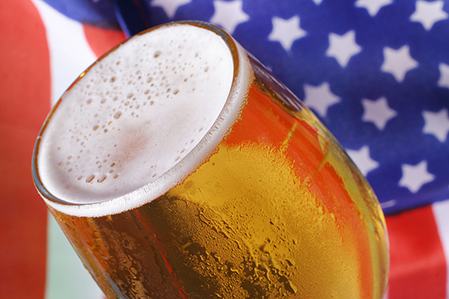 Across the Atlantic Ocean, America’s problems are similar. Americans over the age of 15 are far more likely to be involved in deadly accidents caused by alcohol overconsumption or to die from other reasons related to alcohol, even though people in that demographic drink only three-quarters of the alcohol that Europeans do. Reasons for this disparity are as diverse as the cultural differences. The legal drinking age in the United States is 21, which is higher than both Russia and Ireland, where the threshold is 18. Additionally, Europe tends to have better (and more widely used) mass transit infrastructures, leading to a lower incidence of vehicular accidents as a result of driving under the influence.
Across the Atlantic Ocean, America’s problems are similar. Americans over the age of 15 are far more likely to be involved in deadly accidents caused by alcohol overconsumption or to die from other reasons related to alcohol, even though people in that demographic drink only three-quarters of the alcohol that Europeans do. Reasons for this disparity are as diverse as the cultural differences. The legal drinking age in the United States is 21, which is higher than both Russia and Ireland, where the threshold is 18. Additionally, Europe tends to have better (and more widely used) mass transit infrastructures, leading to a lower incidence of vehicular accidents as a result of driving under the influence.
While the World Health Organization found that Austria and Ireland account for the highest rates of binge drinking in the world, other measures find that the United States is where the most excessive drinking takes place. Fifty percent of the alcohol consumed by adults, and as much as 90 percent of the alcohol consumed by people under the legal drinking age of 21, is done during a binge drinking session, according to the director for the Centers for Disease Control.
Binge drinking, writes Mic, is “intricately connected to American culture.” On many college campuses, it is a rite of passage for young people, some of whom are overwhelmed by the freedom and responsibility of life without parental supervision. During Spring Break, for example, college-aged men consume an average of 18 drinks in a single day, according to the American College of Health.
Such is the extent and severity of the drinking, that The New York Times wonders if the laws meant to stop young people from drinking too much are what influences them to drink all the more when the opportunity presents itself.
The Blame Game
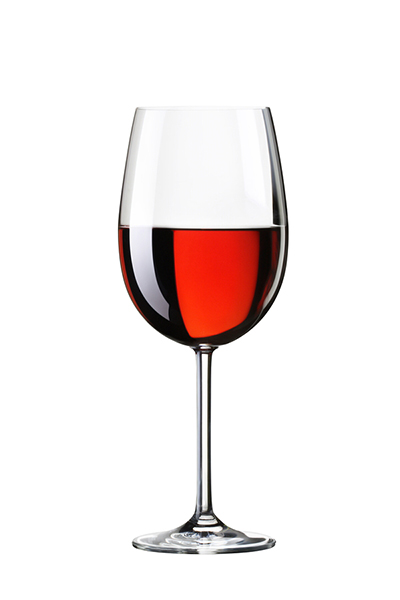 While American college students raucously celebrate the freedom to drink, the European story is a very different one. Drinking has long been seen as a social and cultural pillar, with TIME magazine reporting on teenagers as young as 16 being regularly given wine at dinner. The practice is also found in France, where the Washington Post writes that “there is no regulation of alcohol consumption in private” for children and teenagers, who routinely receive small amounts of alcohol with meals.
While American college students raucously celebrate the freedom to drink, the European story is a very different one. Drinking has long been seen as a social and cultural pillar, with TIME magazine reporting on teenagers as young as 16 being regularly given wine at dinner. The practice is also found in France, where the Washington Post writes that “there is no regulation of alcohol consumption in private” for children and teenagers, who routinely receive small amounts of alcohol with meals.
So novel is the notion of binge drinking in French culture, that the term only entered the French language in 2013. It is part of a move to control a problem; the European Journal of Public Health reported that binge drinking was behind 49,000 deaths in France in 2009, which led to the French health minister proposing a bill that would criminalize the “incitement” of binge drinking in media and advertising.
As usual, the French blamed British drinking habits for the spread of binge drinking in France. The Telegraph named Britain “the binge-drinking capital of Europe,” and many French feel that the problem (or, at least, awareness of there being a problem) was brought to their shores by tourists and holidaymakers from across the English Channel. But such perceptions speak to the deep cultural notions that people – perhaps especially Europeans, with their close borders and long histories – bring to the debate about alcohol. Instead of taking a hard look at the scientific and medical evidence of the damage that rampant alcohol consumption can do, it may be easier just to shrug the collective shoulder and blame it on the way things have always been.
